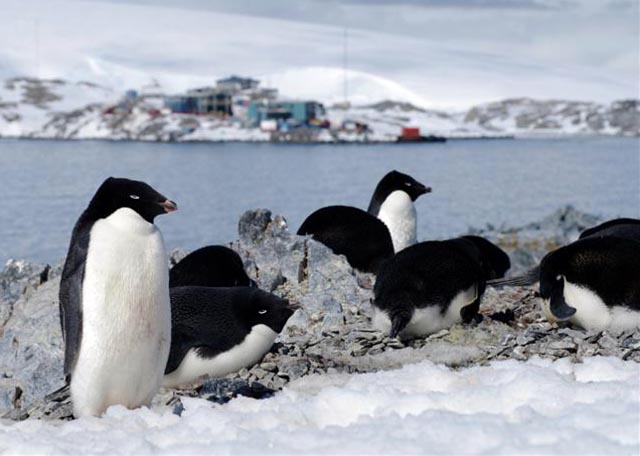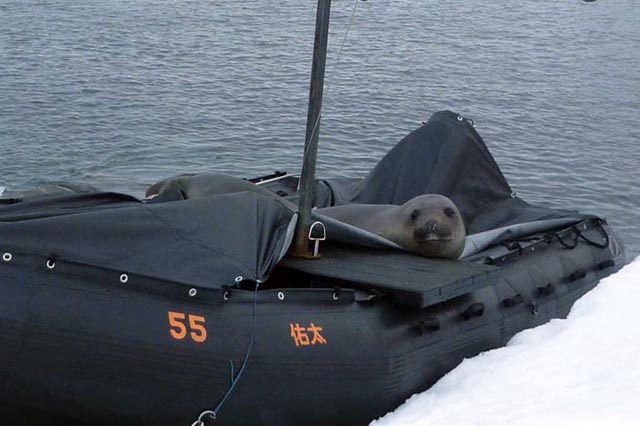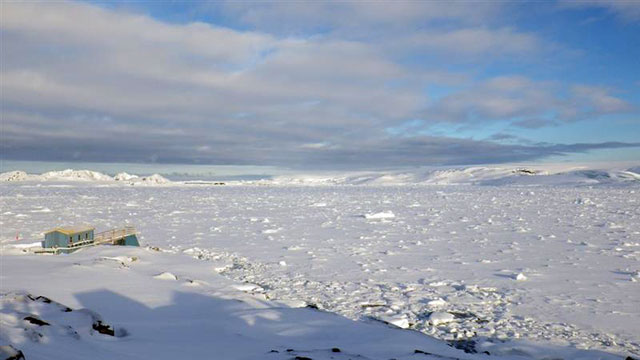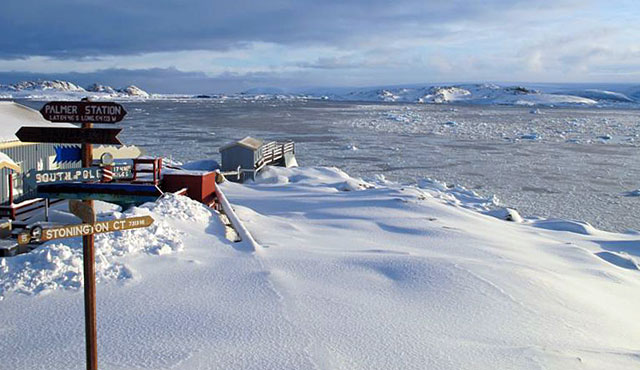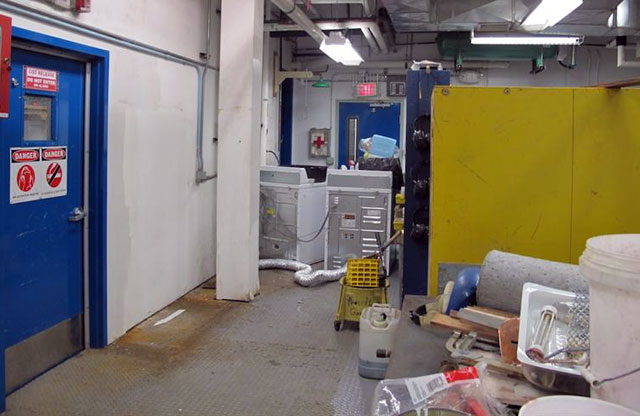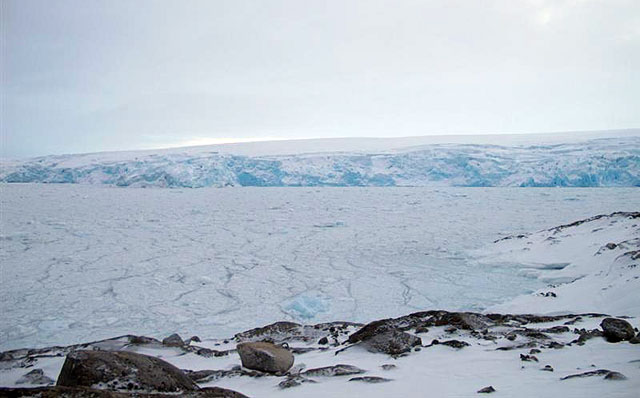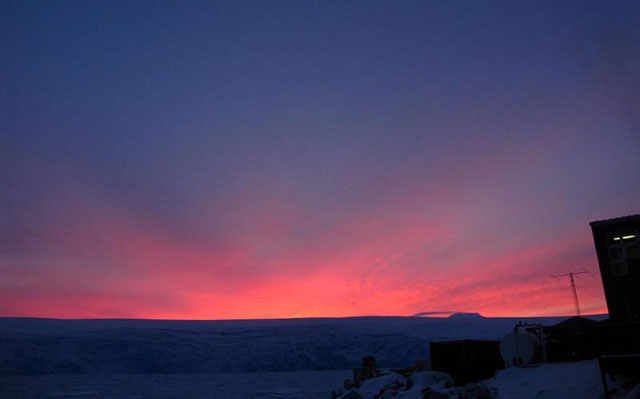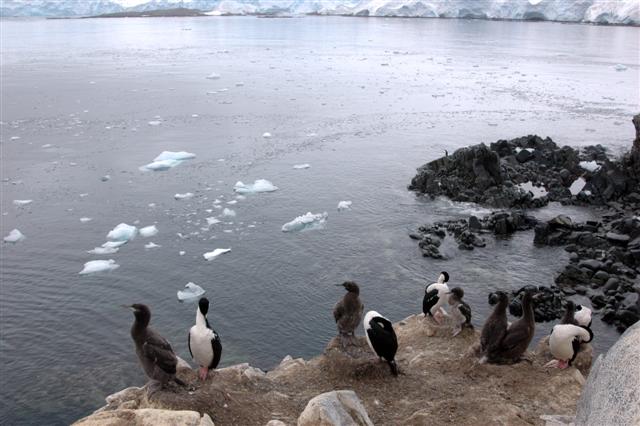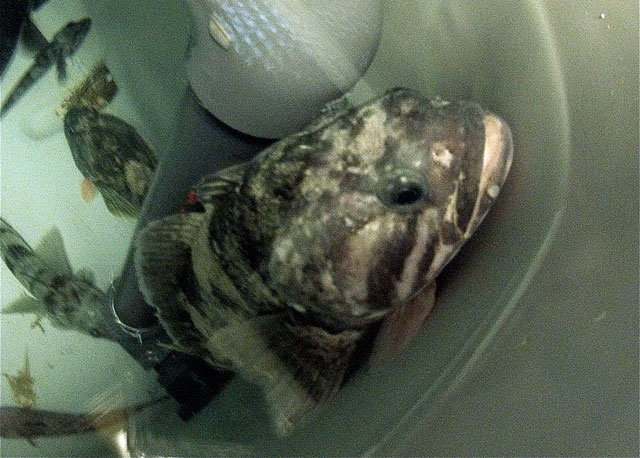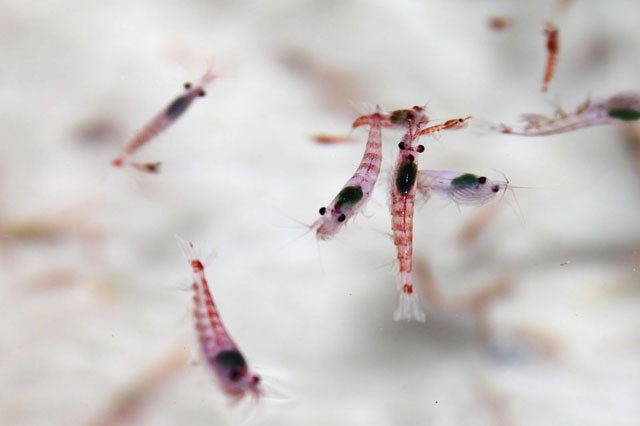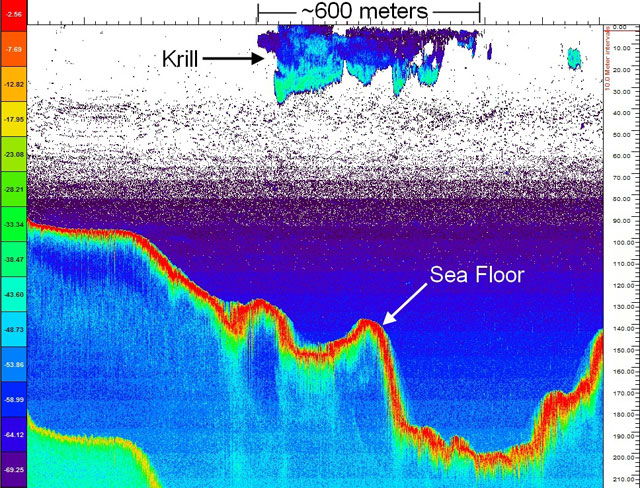|
Palmer Station Archives - 2012 Palmer Station ramps up dock work; skuas raid Adélie nests for eggsPosted December 14, 2012
November passed by fairly quickly at Palmer Station Some of the new arrivals began prep work for a new boat ramp and floating dock that will support Zodiac operations. The installation will occur in two phases. The first, which started last month, should be completed before Christmas, and the second phase will start later in the summer and continue into the winter. Currently, supports and an anchoring system are being installed for the floating dock, and some grading work will be done for the ramp. In order to install the supports for the floating ramp, the crew spent part of the month digging through as much as six feet of accumulated snow and ice before getting down to the rocky shore. Once they crew reached bare rock, they chipped and drilled away to bring it down to a level work area. The anchor bolts had to be installed early in the morning to prevent the melting snow from filling the holes with water and preventing the epoxy from holding the bolts in place. Another member of the research team from Rutgers University The Adélie penguins on nearby Torgerson Island now have eggs in their nests. That has brought several opportunistic skuas to the area to wait for their chance to swoop in and steal any penguin eggs that they can. Broken eggs can be found scattered all over the island in the snow. The Adélie penguin population continues to shrink each year on Torgerson, due to ongoing climate changes documented by scientists here. Several penguin colonies consist of just a few pairs or a pair of penguins. This makes them especially vulnerable to skua attacks, putting the colony at an even greater risk of disappearing. Improving summer weather has allowed researchers to start making regular visits to both Dream Island and Biscoe Point to observe the penguin populations in those areas. Just like back home in the United States, Palmer Station celebrated Thanksgiving near the end of November. There where two turkeys and a ham made for the meal. One of the turkeys was meticulously smoked by two station support members overnight leading up to the feast, and it was particularly tasty. There was stuffing and cranberry sauce, as to be expected, and even some cranberry relish. And there were 14 homemade pies for the crew of 38 people. There was more than enough food for everyone, though it didn’t last long in the leftover fridge. The ground was still covered with snow by the end of November, with random snow showers still coming though. The new snow would soon melt in the blazing sunshine, along with the existing snow piles, turning the roads into a wet mush. With the Gould scheduled to arrive at the start of December, and the upcoming cruise ship visits, November may be the last calm month of the summer season here at Palmer. Science regroups for summer field season at Palmer StationPosted November 21, 2012
October started with just one science group at Palmer Station To reach the U.S. Antarctic Program’s After putting in a field camp on King George Island farther north, the Gould made its way down the Antarctic Peninsula, only to be slowed down considerably by sea ice on the southern side of Anvers Island. The ship had to ram a path through the ice to get to the station. This turned out to be very time- and fuel-intensive, as the ice was heavily packed, turning a two-hour transit into a nine-hour ordeal. 
Photo Credit: Peter Rejcek/Antarctic Photo Library
Scientists with Rutgers University prepare a glider for deployment during a previous field season.
The science groups that arrived represent a variety of polar biological research interests, ranging from the smallest marine organisms to the iconic Adélie penguins. The latter are disappearing from the region due to climate change. A group led by co-principal investigator (PI) Philippe Tortell They will also study the seasonal changes in phytoplankton photosynthesis, and conduct controlled experiments to see how a change in carbon dioxide levels may affect phytoplankton. This is the first time the group has worked on station. Much of their time spent over the first few weeks involved setting up their instruments, with limited sampling in the ocean due to the persistent sea ice. PI Shelley Bench from Stanford University Team members with the seabird component of the Palmer Long Term Ecological Research (LTER) Another team from the Palmer LTER, headed by Oscar Schofield at Rutgers University 
Photo Credit: Sean Bonnette
Scientist Sven Kranz navigates around the Palmer Station area to collect water samples for a project studying phytoplankton.
A couple of scientists will be at Palmer through March for the microbial biology study that is part of the Palmer LTER that Hugh Ducklow Ducklow is also the PI for a separate project in which one scientist will be at the station to take water samples in an effort to understand the production and export of organic matter from the surface of the ocean to the seafloor in the coastal Antarctic marine ecosystem. Even with all the science work going on, personnel still found time to have a Halloween party. The variety of costumes ranged from inspired scientific puns, to clowns, superheroes, and even some animals. The station science personnel skillfully decorated the bar with cobwebs, spiders and even a giant flying bat. It was a very fun way to end the month. This was a colder-than-average October. More snow accumulated, though the exact amount of was hard to measure. The wind did a very good job of blowing it all over station, and caused several drifts that measured several feet in depth. The sea ice broke up at the end of October, allowing the science groups to leave station and do their sampling. This also gave rise to the hope that winter would finally give up its icy grip on the area, and spring would kick into gear. Palmer Station bumps up against some work on the pierPosted October 19, 2012
September brought major changes to Palmer Station With the arrival of the Gould, the once quiet station was thrown into top gear. One of the first issues that needed to be addressed was installing some extra pier bumpers to the existing ones so the ship would sit farther away. 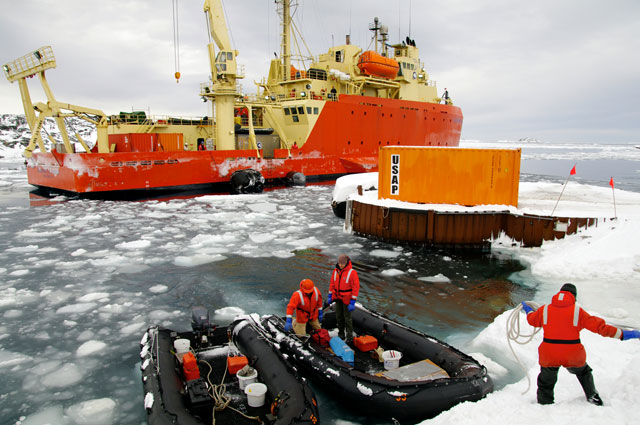
Photo Credit: Sean Bonnette
Palmer Station personnel and the LMG crew unload new bumpers for the pier.
While in dry dock earlier this year, a dent was found on the underside of the Gould that was determined to be from a ledge near the Palmer pier. To keep the ship from being damaged after the repair, it would need to be kept farther away from the pier. In the warehouse in Punta Arenas, Chile, there was a single bumper — but that alone wouldn’t space the boat out far enough. A second bumper was sourced locally in Punta Arenas from a field near the airport. Shortly after arriving in Hero Inlet, the Gould lowered down both bumpers so that they could be secured into place. After the bumpers were in place and secure, the ship was able to tie up to the pier with no issues. The weather for the cargo operations was very cooperative. Milvan containers were swung from ship to shore with no issues, and then several were swung back to the ship full of waste and northbound cargo. Two incoming milvans were full of the station’s resupply of food for the summer season, ranging from cuts of beef to juice concentrate, frozen veggies, and even ice cream. Normally, with the first boat of the season, the Gould would also offload fuel, but that has been postponed for later in the summer. The entire port call lasted six days, during which the winter crew turned over their jobs and emergency response duties to the summer team. This made for a very busy port schedule. In addition to their regular duties, all personnel also serve on one or more emergency teams, including fire, glacier search and rescue and ocean search and rescue. Turnover for the fire team included a drill. Before anyone knew it, the port call was over, and the summer crew found itself at the end of the Palmer pier, waving goodbye to their northbound counterparts. Normally, at this point, the station crew would perform a traditional jump off the pier, wishing the northbound bunch a safe trip, but the brash ice closed in behind the Gould as it left. For this trip north, well wishes and enthusiastic hand-waving would have to suffice. Palmer Station begins transition to new seasonPosted September 14, 2012
August was a month of transition at Palmer Station The first weekend of August was busy. Not just from work obligations but due to the rush to write, shoot and edit a short film for the 48-hour movie category in the annual Antarctic Winter International Film Festival (WIFF). To ensure that the films would be made over the weekend, there was a list of required items that each submitted film needed to have. There were a large number of films from most of the crewed Antarctic stations, and Palmer submitted two films, with nearly everyone getting involved. One of the films revolved around the everyday interactions between the crew and the things that they might end up saying in their heads when small community annoyances come up. The other movie was a short sub-one-minute film focused solely on making no sense and included the five required items with improvisational acting. While neither film received enough votes to come out as an overall winner, everyone involved agreed it was a great time making them. Science has ramped down but still moves forward with two researchers who are continuing winter work on Antarctic fish embryos. The scientists have wrapped up experiments and are preparing samples to send north at the end of September. It was a windy month, with temperatures staying in the 20s on average. There were also a few colder days that hovered around 0F for highs, before spiking to around 40F. This left the winter-over population wondering if the temperatures would stay this high for the remainder of the winter. Well, they didn’t. After having an unseasonably warm week, the temperatures returned to normal, dropping back into the 20s. As August came to a close, it wasn’t uncommon to spot large flocks of cormorants flying in formation in the area around Palmer. There have also been more sheathbills and petrels flying in the air. Even a minke whale was spotted near the station, despite a thin layer of sea ice. The last weekend of the month brought the winter-overs together to show off art and other creative projects that they had worked on over the previous months. Projects ranged from paintings to wood sculptures to knitted items and even an ice sculpture. The amount of projects on display filled up the station galley. In just a few short weeks, with the end of August, the majority of those now on station will make their way north, and the summer science season will begin. Early spring cleaning occupies crew at Palmer StationPosted August 10, 2012
July was a windy month at Palmer Station As nice as fireworks would have been, Independence Day festivities relied more on BBQ and patriotic cupcakes. Compared to the midwinter celebration a few weeks before, the party for the Fourth was fairly laid back and relaxed. Another section of the aquarium is being cleaned and updated, as part of a renovation project that started last winter. The work includes cleaning the existing electrical installation and recessing it in the wall. The wall will also get a water-resistant covering that will help it to hold up better in the wet-lab environment. The garage area is also undergoing a thorough cleaning, along with reorganization. Home to both Logistics and the heavy shop, the garage is one of the busiest spots on station. The floor and walls are being repainted and work centers reorganized to make better use of the limited space shared by two departments. Years of accumulation, like in any garage, were cleaned out, leaving even more space than from reorganization alone. Wildlife sightings of seals and birds were down from June. Several leopard seals have been spotted on ice floes in Arthur Harbor. Sheathbills continue to hang around the area. Much like pigeons in the city, they can be found scrounging for any food they can find. There hasn’t been much noticeable sea ice buildup so far at Palmer this season. There has been a few times where the threat of being iced in neared. But without fail, the winds would pick up and blow the ice out to sea over the course of a few days. Much to the chagrin of station residents trying to take time-lapse footage, this would usually take place overnight in the dark. Direct sunlight returned to Palmer in July. Despite being out of view for only about a month, the return of the sun was a welcome sight. And with the cooperation of the winds and clouds, there have been several spectacular sunrises and sunsets viewable from station. Emergency teams continued with their training last month. In addition to his or her regular job duties, everyone wintering at Palmer is also on at least one emergency team. Besides fire and trauma teams, Palmer also boasts a Glacier Search and Rescue (GSAR) squad and an Ocean Search and Rescue (OSAR) team. Ready for just about any emergency — but hoping that they don’t need to respond — the teams help keep the winter- over crew involved and the station safe. The winter season at Palmer is two-thirds complete. With two months left, there is still plenty of time for the sea ice to form and maybe enable some travel to the nearby islands without the use of inflatable boats. Maybe. Palmer grows quiet in winter as researchers, widlife leave areaPosted July 20, 2012
June was a transition month at Palmer Station 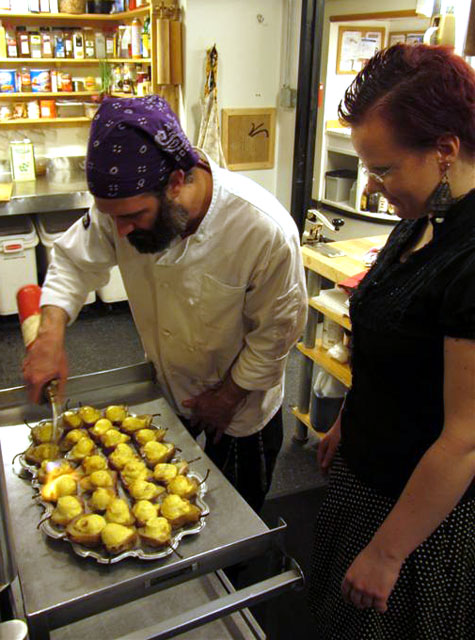
Photo Credit: Janice O'Reilly
Russell Freeman and Irina Mueller prep crème brulee for dessert at the Midwinter dinner at Palmer.
Two scientists from research groups led by Bill Detrich at Northeastern University In the week leading up to Midwinter, a special Antarctic holiday that celebrates the winter solstice, the Gould was loaded up with the rest of the northbound hazardous waste collected at Palmer during the last two years. Every two years, all the hazardous waste onsite at Palmer is packaged into milvans and loaded into the cargo bay of the Gould to begin a month-long journey north to Port Fourchon, La., for disposal. To prepare the waste to be loaded, U.S. Antarctic Program (USAP) The Gould departed on Midwinter morning, giving the remaining winter-overs just enough time to celebrate with a family-style meal prepared by chef Russell Freeman, with help from various station members. The size of the wintering crew meant that just about everyone had a hand in the preparations for this important celebration. 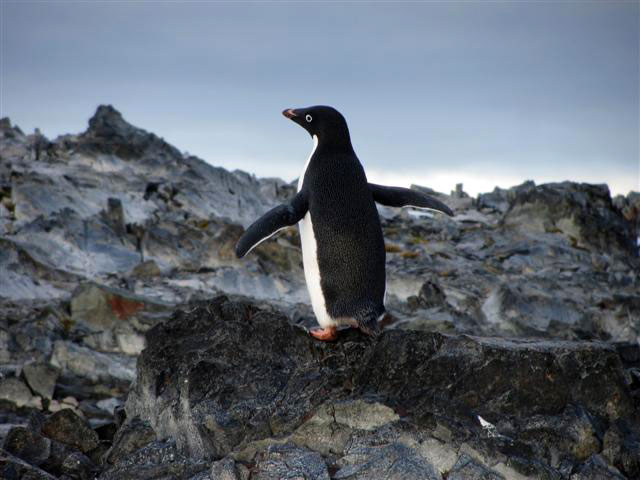
Photo Credit: Janice O'Reilly/Antarctic Photo Library
A lone Adélie penguin on Torgersen Island near Palmer Station in May 2012.
The festivities lasted late into the evening, with stories of past seasons and laughter shared by the Palmer community. A few days later, various station members plunged off the pier into the ice-cold waters for a belated tradition to celebrate the lengthening days to come. The wildlife population around Palmer has decreased dramatically over the past month. Despite best efforts to locate them, it appears that the penguins that were remaining on the outlying islands have moved on for the winter. In their absence, there are still plenty of elephant seals, along with fur and leopard seals. There were also several minke whale sightings in the waters around station. For the better part of the next three months, the crew at Palmer will be isolated, with no ship traffic. Not to worry, though; we are well prepared and there are winter projects to keep us busy before summer field season returns. Science wrapping up for 2011-12 season at Palmer StationPosted June 22, 2012
Science labs bustled with activity during May at Palmer Station Research divers collecting samples for ocean acidification studies in the station lab completed their work last month. The study, led by Charles Amsler and James McClintock The lone grantee on station for an unrelated project looking at the ecology of Belgica antarctica, the only free-living insect found on Antarctica, also wrapped up his season’s research. Belgica larvae undergo extreme stress, including freezing of body fluids and dehydration. The researchers, led by Richard Lee at Miami University Other research under way at Palmer included various studies related to the ecology of Antarctica’s unique species of icefish, and a project sampling the microbes that live in the ocean that get energy from both organic matter and sunlight, called photoheterotrophs. Palmer Station felt the beginning of winter during May, as daylight hours shortened and temperatures dropped. However, populations of penguins could still be observed, some busily transferring pebbles. Interestingly, Adélie penguins were observed on the north and south sides of nearby Torgersen Island on three different occasions. Gentoo penguins were sometimes observed swimming in the open water near the station. Early in the month, three chinstrap penguins were identified on Nightmare Island during a combined operation for the survival cache swap on Dream Island for ocean search and rescue (OSAR) operations, and science support fieldwork for obtaining GPS reference points for the Polar Geospatial Center at the University of Minnesota. Other bird populations observed during the month included blue-eyed shags, kelp gulls, Wilson’s storm petrels, snowy sheathbills, and giant petrels (adults and grown chicks). A small group of terns (unidentified) continued to congregate at the far shore of Arthur Harbor near the glacier behind the station. Fur, elephant, crabeater and leopard seals were still present in the Palmer vicinity. A group of humpback whales was seen by the OSAR team near Halfway Island. As noted earlier, May was relatively mild, but as temperatures started to drop, the cold was counterbalanced by many great sunrises and sunsets that illuminated the mountains to the south. Except for some gusty days in the middle of the month, May was a fairly calm month. Very little sea ice was seen, with only a couple of days of heavy brash ice passing through. One iceberg came into view near month’s end. The glacier was heard calving several times during the warmer, rainy days. There was a healthy coating of snow blanketing Palmer Station heading into June. This story mostly compiled from reports by Janice O’Reilly, Winter Assistant Supervisor of Lab Operations, and research associate Neal Scheibe. Something fishy happening around Palmer StationPosted May 18, 2012
Fish! That’s what it’s all about here at Palmer Station The station’s laboratories are full of scientists — the majority of them studying the exotic fish that swim in the frigid Antarctic waters of the Southern Ocean. The aquariums are filled with the icefish Chaenocephalus aceratus, which are fascinating due to the lack of oxygen-carrying hemoglobin in their blood, and also the ever-curious, red-blooded rock cod Notothenia Coriiceps. The research vessel Laurence M. Gould Each return by the Gould brought six large totes filled with new fish that were caught by fishing pots and benthic trawls around Dallman Bay to the north of Anvers Island where Palmer Station is located. Fish were also caught from Crystal Sound near the Antarctic Circle. After careful transfer of the fish to our aquariums, the scientists collect tissues from the specimens and also prepare them for in vitro fertilization to produce embryos. One of the biologists’ main goals this season is to examine how the embryos grow at elevated temperatures and in different conditions. Station science also included our two dive researchers from the University of Alabama at Birmingham Scientist Yuta Kawarasaki from Miami University Lastly, two members of the support staff on station have been assisting our bird researchers, Bill Fraser and Donna Patterson, with late-season weight measurements of giant petrel chicks on nearby Humble Island. These remarkable and majestic birds are born in January and fledge in May, just as the winter months grow harsh. While our light is finally starting to diminish with each day here just north of the Antarctic Circle, our climate continues to stay relatively warm, and we have yet to see any significant snow buildup. Instead, rainstorms and sudden ice storms seem to dominate the weather patterns, and our surrounding waters continue to stay very open for Zodiac travel and science opportunities. As we merge into May, the fish science will continue on with another several rounds of fishing runs by our colleagues on the Gould. We’ll see what we can catch! British Royal Navy scans seafloor around Palmer StationPosted April 20, 2012
Even though grass, in fact, does grow on the islands around Palmer Station The month started off with the successful completion of a drilling operation on nearby Amsler Island by a group led by James Bockheim 
Photo Credit: Ryan Wallace
The British Royal Navy HMS PROTECTOR, in the distance, and its survey boat the JAMES CAIRD, conduct a survey of the seafloor around Palmer Station.
The research groups of the Palmer Long Term Ecological Research (LTER) Dive researchers led by Jim McClintock and Chuck Amsler 
Photo Credit: ©DigitalGlobe background imagery; HMS PROTECTOR bathymetry; image courtesy of Paul Queior
Bathymetry from the Royal Navy scan of the seafloor around Palmer Station.
Last, but not least, scientist Yuta Kawarasaki, a graduate student at Miami University The research vessel Laurence M. Gould March saw the last official visits by guests of the tour ships Ushuaia and the Corinthian II, and we also had a visit by the newly acquired ship of the British Royal Navy On the social side of things, the director of our construction and maintenance department, Zee Evans, hosted an amazing art show in the bar and lounge, featuring outstanding paintings, photos, handcrafts, and live performances of poetry and songs. There was also a wine tasting, with wines brought from all parts of the world. High-profile visitors make an appearance at Palmer StationPosted March 9, 2012
February began and ended with visits from distinguished guests. Lindblad Expedition’s National Geographic Explorer came to Palmer Station Climate Reality cruise notables
Needless to say, it was an exciting day. The guests were given a slightly expanded tour of the station, while many of our local scientists answered questions aboard the Explorer. Through the middle of February, Palmer Station was the welcoming recipient of many days of sunshine and calm weather. We worked hard to convince short-duration residents that this is not the norm. Scientists Chuck Amsler and Jim McClintock James Bockheim His group returned to collect data from soil stations that were left over the winter. They have also been drilling on Amsler Island in order to place instrumentation that will allow them to study permafrost. Fuelies from McMurdo Station arrived to continue working on the wax buildup in one of Palmer’s bulk storage tanks. They have successfully removed all the remaining liquid fuel and shoveled out the wax. Now they are working on removing the lining in the tank. To close out the month, another group of distinguished guests, the Blue Ribbon Panel The panel has been tasked with reviewing the current operational status and facilities of the U.S. Antarctic Program The panel visited McMurdo and South Pole Science continues amid season of odd weather eventsPosted February 17, 2012
This season’s odd weather continued in January. The sea ice finally receded south, but repeated snowfalls plagued the month, occasionally accumulating overnight. Though snow should seem normal for Antarctica, in our neck of the woods, the heart of summer is generally just a bit too warm for it. Perhaps the snow was aided by the distinct lack of sun and ambient light compared to previous years, which was actually quantifiable in the weather station data. In short, it’s been gloomy. Still, science must go on at Palmer Station 
Photo Credit: Kerry Kells/Antarctic Photo Library
Scientist Bill Fraser, head of the Palmer LTER seabird component, measures the length of a brown skua chick's beak near Palmer Station.
The “buggers,” led by Rick Lee of Miami University The zooplankton arm of thePalmer Long Term Ecological Research (LTER) The LTER birders found that all the mating pairs of south polar skua in the local vicinity have failed to raise offspring this season. In recent years, the skuas have been in decline, just like Adélie penguins, but their complete failure to reproduce in the local area is unprecedented. 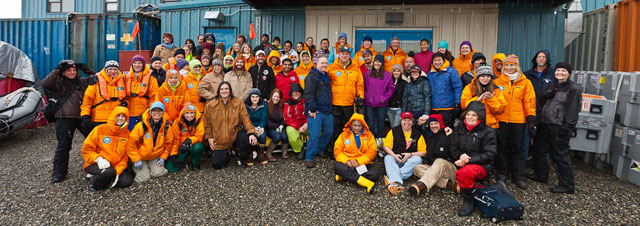
Photo Courtesy: Brian Nelson
Former Vice President Al Gore, center, poses with residents of Palmer Station and members of the Climate Reality Project.
The research vessel Laurence M. Gould The LTER scientists also made their annual visit to the British Antarctic Survey’s Rothera Station The final week of January and the first week of February was a mass hysteria of overloaded schedule: another port call from the Gould, visits from two cruise ships, one yacht visit, and two off-shore lectures. We were also graced with a special appearance by former Vice President Al Gore Palmer hosts LTER site review and related science in DecemberPosted January 13, 2012
This year’s persistent sea ice finally shoved off in early December, leaving an open boating area around Palmer Station Early in the month, the research vessel Laurence M. Gould The station was abuzz with scientists for several days — some longstanding members of the Palmer community, and some completely new to Antarctica. The assessment team tagged along with all subsets of the Palmer LTER: taking water column samples, counting birds, and echo sounding for krill, as well as going for a short mock-cruise on the Gould. Our visitors also showed great interest in station life, non-LTER science, and support logistics, so everyone was kept very busy. Paul Morin The Oceanites group is interested in using high-resolution satellite imagery to track, count, and even differentiate species of penguins in a colony. They have already found many previously unknown penguin colonies using this technology. After the site review, we experienced a couple weeks of normalcy. The phytoplankton arm of the Palmer LTER launched another autonomous underwater vehicle (AUV), which is now sampling an area known as the Palmer Deep, just south of Anvers Island. A glider launched in early November is continuing its journey to the British Antarctic Survey’s Rothera Station The rest of the LTER is seeing increases in oceanic biological activity, normal for this time of year. The zooplankton arm measured massive aggregations of krill in the area, which are always welcome because they attract more megafauna, or large critters like humpback whales. In fact, in the days leading up to Christmas, the boating area was teeming with humpback whales. Lots of folks made it out in Zodiacs, and some were lucky enough to get very close encounters by these curious whales. Amazing holiday tidings indeed. |
Home /
Around the Continent /
Palmer Station Archives - 2012
"News about the USAP, the Ice, and the People"



For USAP Participants |
For The Public |
For Researchers and EducatorsContact UsU.S. National Science FoundationOffice of Polar Programs Geosciences Directorate 2415 Eisenhower Avenue, Suite W7100 Alexandria, VA 22314 Sign up for the NSF Office of Polar Programs newsletter and events. Feedback Form |

